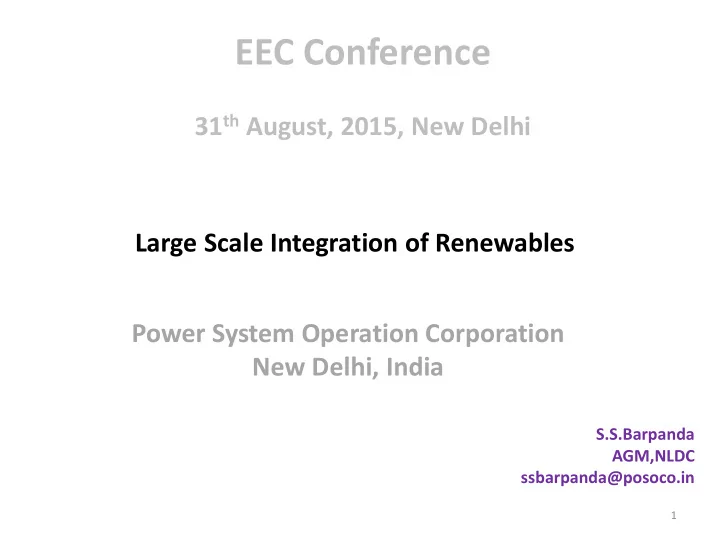

EEC Conference 31 th August, 2015, New Delhi Large Scale Integration of Renewables Power System Operation Corporation New Delhi, India S.S.Barpanda AGM,NLDC ssbarpanda@posoco.in 1
Some of the Large Power Grids in the World Source: GO 15 (2013 Leaflet) 2 2
Typical Statistics Power System Related Installed Capacity: Peak Demand Met: Grid Operation Related 141 GW 275 GW Renewables Capacity: Energy Met (Avg.): 3100 MU/day 36 GW – Wind (23 GW), Solar (4 GW) Max. Wind Generation: No. of 400kV & above Trans. 240 MU/day Line: 1300 Nos., 765 kV (65 Nos.) Short Term Open Access: 240 MU/day Number of Generating Units: 1750 Nos., 500 MW & above (140 Nos.) Inter-regional Exchange: 225 MU/day 3
4 Indian Power Sector Power Installed Capacity = 275 GW Thermal Hydro Nuclear Renewable Total Wind Small Solar Biomass Total Hydro 191 GW 42 GW 6 GW 36 GW 275 23.5 GW 3.8 GW 4.5 GW 35.8 GW 4 GW
Diversity in Demand Assam Kerala All India Maharashtra Delhi
Regional Geographical Diversity WR ER Demand Met (ER) NR SR Diversity on account of geographical location, seasons, time of day, load, etc. NLDC - POSOCO 6 11/18/2015
Load Curve and Diversity Hydro Solar All India Pumped Hydro
Variation in Hydro Generation Summer Monsoon Winter
Typical Load Curves – Ramping Requirement Winter Summer Typical All India Load Curve Evening Peak @ 200 MW/min for 40 minutes Monsoon Morning Peak @ 140 MW/min for 40 minutes 9
Expected All India Duck Curve (Sample: 20000 MW of Solar Generation) Head: Evening Peak Actual Demand Neck: Steep ramping Net Load Belly: Decrease in net load Increase in AC loads would reduce the belly!! 10 Source: NLDC SCADA data, CAGR assumed: 8%
Evolution of Power Market in India FUTURE … 2014: Deviation Settlement • Ancillary Market • April, 2012: Sub-Hourly Market Capacity Market (15 Min Bidding in PX) • Peaking Power 2011: Transmission Pricing (POC) 2010: Power Market, REC 2009: Grant of Connectivity, LTA and MTOA 2009: Trading License 2009: Congestion Management 2009: Imbalance (UI) 2008: Power Exchange 2004: Open Access 11 11/18/2015 NLDC - POSOCO
Products in Different Time Frames 3 Years – 25 – 12 Years < 3 Months 3 Months Medium Short Long Term Term Term Products in the Short Term Market Bilateral Day - Contingency PX Bilateral - - FCFS Ahead Advance
Vibrant REC Market • Introduced in 2010 Web Portal - www.recregistryindia.nic.in • Registered Generators – 1094 Nos. • Registered Capacity – 4809 MW • More than 26.5 Million RECs issued • Trading Volume of more than 18 Billion Rupees
REC Portal Home Page | https://www.recregistryindia.nic.in Key Highlights:- • Transparent • Accessible pan India • User Friendly • Real Time Data on REC • Single Touch Point for information for RE Generators
Paradigm shift in operations • Classical despatch – Forecast your load; generation fleet has to follow load • Renewable Generation: the first game changer – Forecast load as well as RE; Load-RE or Net Load more important – Conventional generation has to follow net load • Storage/Distributed Generation/Electric Vehicles – From consumers to prosumers • A flexible power system – but one that does not break.
Provisions Regarding Ramping • Provisions in the Indian Electricity Grid Code (IEGC): – Operating Code (Section 5.2): • System Security Aspects - Ramping of – All thermal units greater than 200 MW. – All Hydro units greater than 10 MW • Sudden change in generation / load by the utilities of more than 100 MW without prior intimation to and consent of the RLDC. – Scheduling and Despatch Code (Section 6.4) • Generators to declare rate of ramping up / ramping down in a 15 minute block. • Acceptable ramping rate – 200 MW/Hour (in NER 50 MW/Hour) • CEA Standard Technical Features of Super-Critical Units – Ramp rate: + 3% per minute (above 30% loading) – Technical minimum load of super critical units – 40% – Two shift operation 16
All India Plant Load Factor (PLF) – Coal & Lignite based plants 80 Annual Average PLF 75 70 65 60 55 50 Fuel shortage , Change in ‘Peak -to-off- Peak Ratio’ NLDC - POSOCO 17 11/18/2015
Recommend
More recommend